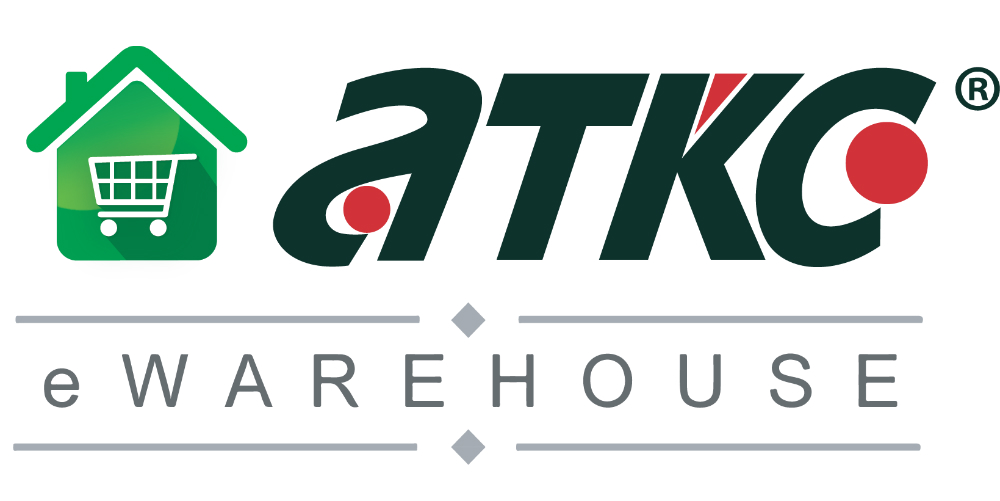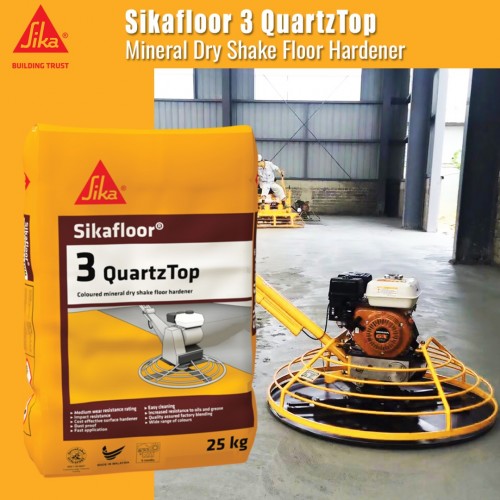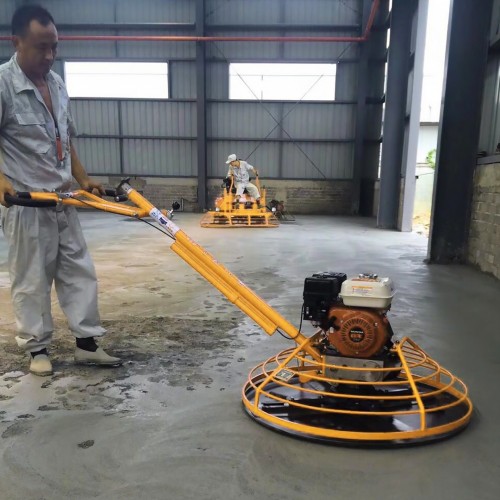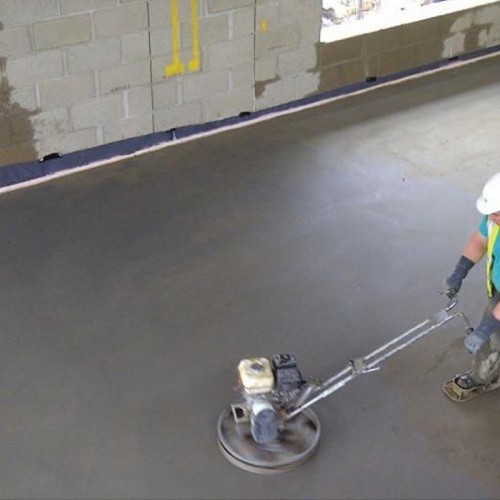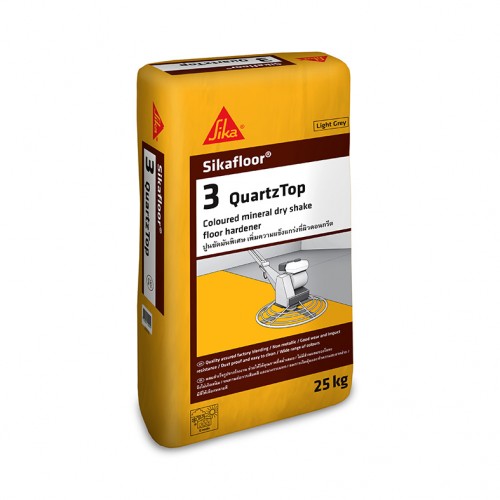Sikafloor-3 QuartzTop Mineral Dry Shake Floor Hardener 25KG (Natural)
Sikafloor-3 QuartzTop Mineral Dry Shake Floor Hardener 25KG (Natural)
- Brand Sika
- Model: SK-F3Q25-N
Description
Sikafloor®-3 QuartzTop is a one-part, pre-blended, (coloured) mineral dry shake hardener for concrete comprising of cement, specially selected quartz mineral aggregates and admixtures.
Characteristics / Advantages
▪ Medium wear resistance rating.
▪ Impact resistance.
▪ Cost effective surface hardener.
▪ Dust proof.
▪ Fast application.
▪ Easy cleaning.
▪ Increased resistance to oils and grease.
▪ Quality assured factory blending.
▪ Wide range of colours.
Specification
Product Information
▪ Composition: Natural mineral aggregates graded and mixed with cement, admixtures and pigments.
▪ Packaging: 25 kg bags
▪ Appearance / Colour: Natural
▪ Shelf Life: 6 months from date of production
▪ Storage Conditions: Store in original, unopened and undamaged sealed packaging in dry conditions at temperatures between +5 °C and +30 °C.
▪ Density: ~2250 kg/m³ (28 days)
System Infomation
▪ System Structure:
- Substrate: Fresh concrete slab (See Substrate Quality )
▪ Curing compound: Sikafloor® ProSeal -22, Antisol®-A or Antisol® E
Use products mentioned above as indicated in their respective Product Data Sheets.
Application Information
▪ Consumption:
- Dry shake: Manual or machine application of Sikafloor®-3 QuartzTop Levelling of surface by means of power trowel or laser screed. Final smoothing with power trowel.
- 4–6 kg/m².
▪ Ambient Air Temperature: +5 °C min. / +30 °C max.
▪ Relative Air Humidity: 30 % min. / 98 % max.
▪ Substrate Temperature: +5 °C min. / +30 °C max.
▪ Applied Product Ready for Use: At +30 °C:
- Foot traffic: 24–48 hours
- Light traffic: 7–10 days
- Normal traffic: 28 days
The above values are dependant upon the concrete reaching its design strength for serviceability and will be affected by the type of cement used in the base concrete, changing ambient conditions, particularly temperature and relative humidity.
- the consumption will depend on application method and the concrete mix (w/c-ratio)
- This figure does not allow for surface profile and wastage.
Uses
▪ Sikafloor®-3 QuartzTop may only be used by experienced professionals.
▪ Sikafloor®-3 QuartzTop provides a hard wearing, mineral dry shake topping for monolithic floors.
▪ When sprinkled and trowelled into fresh wet concrete floors, it forms a wear resistant smooth surface.
▪ Typical uses are in warehouses, factories, shopping malls, public areas, where wear durable and wear resistant floor is the key requirement.
Application
Mechanical Application - Automatic spreader in conjunction with a laser screed
▪ Spread Sikafloor®-3 QuartzTop evenly onto the concrete immediately after screeding at 4-6 kg/m² in one application.
Manual application
▪ Dependent on the conditions, remove the surface bleed water or allow it to evaporate. Sprinkle Sikafloor®-3 QuartzTop onto the screeded concrete evenly in 2 stages (first stage: ~3 kg/m²; second stage: 1–3 kg/m²).
▪ Care must be taken to apply the product without creating ripples etc. in the concrete surface. Casting Sikafloor®-3 QuartzTop powder carelessly or further than 2 metres from point of casting will reduce the consistency of finish.
▪ Compaction: The first application must be worked into the slab followed immediately by the application of the second stage quantity of Sikafloor®-3 QuartzTop.
Notes:
- Never add water to the surface where the dry shake has been applied.
- Sikafloor®-3 QuartzTop results in the slab surface becoming stiff more quickly than usual. Careful trimming must take place along the edges where adjoining slabs are to be poured.
- Final finishing for closing pores and removing undulations can be achieved either by hand or powered trowel.
Application time
▪ Application time for dry shake products is influenced by every variable which affects the placing of concrete, and can therefore vary substantially, depending on the prevailing conditions.
▪ For mechanical application with automatic spreader and laser screed, the spreading can start almost immediately after the concrete has been levelled to allow for the hydration of the dry shake.
▪ Compaction with the trowel can start as soon as the weight of the power trowels is supported by the concrete.
▪ For manual application, the dry shake must be spread once the concrete can be stepped on, without leaving a print deeper than 3–5 mm.
▪ Periodical checking of the condition and development of the concrete will determine the correct time frame for each stage and sequence of application.
Curing Treatment
▪ Cure and seal Sikafloor®-3 QuartzTop immediately after finishing using a curing compound, Sikafloor® ProSeal-22, Antisol®-A or Antisol® E (Refer to the relevant Product Data Sheet).
▪ The sealers additionally harden the surface, decrease dust and reduce liquid absorbtion.
▪ Joints: After finishing operations and completing saw cuts, clean off any residual saw lubricant / slurry without delay.
▪ Joints can be filled with Sikaflex® PRO-3 or another appropriate Sikaflex® sealant in accordance with the floor design requirements.
Important Considerations
▪ The application of Sikafloor®-3 QuartzTop must not be carried out in strong wind or in dry conditions.
▪ Do not use concrete where some cement has been replaced by fly ash, as this makes the mix sticky and less workable.
▪ Variations in concrete characteristics such as water content and cement may lead to slight colour variations.
▪ Dry shake hardeners give a finish to concrete with some colour variation across the floor due to the natural variability of the concrete onto which they are applied.
▪ To ensure optimum of colour consistency, it is essential that the floor laying operation is as clean and protected from the environment as possible.
▪ Colour variation during the drying out period is normal for this system and is to be expected.
▪ Every effort must be made to ensure an even application of Sikafloor®-3 QuartzTop. Correct timing and trowelling techniques are essential.
▪ At low relative humidity (below 40 %), efflorescence can appear on the surface.
▪ At high relative humidity (above 80 %), bleeding, slower curing and hardening can occur and extended finishing operations be required.
▪ Shrinking joints are to be created within two days. Expansion joints are reflected in the surface of the floor.
▪ As a consequence of repeated power trowelling, which brings tension into the surface, fine cracks may appear on the floor. This observable fact is typical for all power trowelled concrete surfaces and does not have negative impact on the floor performance.
